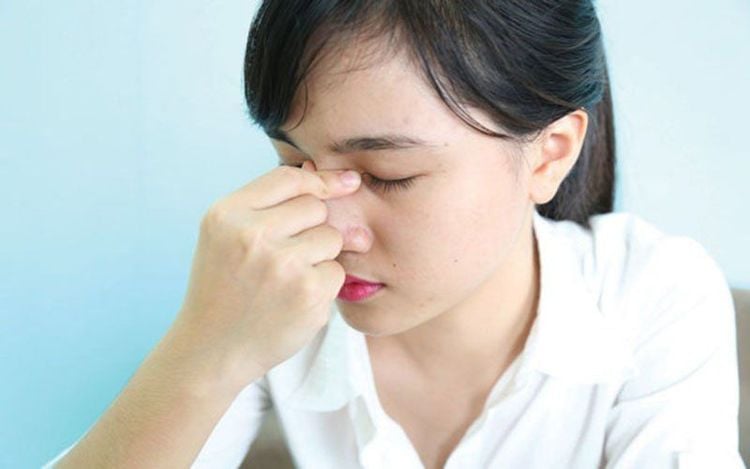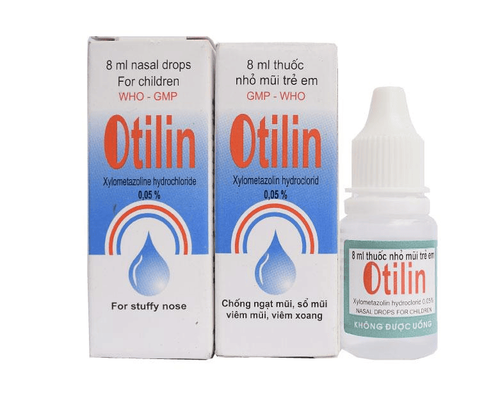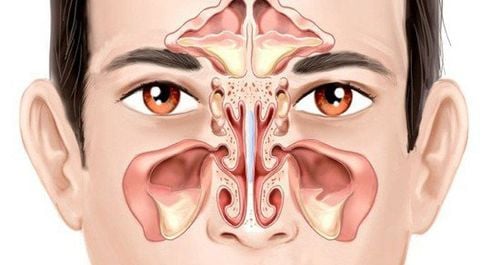This is an automatically translated article.
The article was professionally consulted with Specialist Doctor II Nguyen Van Thai - Ear, Nose Throat Doctor - Department of Medical Examination & Internal Medicine - Vinmec Danang International General Hospital.Sinusitis is one of the common chronic diseases in Vietnam. If not treated promptly, the patient can live with the disease for the rest of their lives.
1. What is sinusitis?
Sinus is the spongy cartilage inside the bone, including the nasal sinuses, frontal sinuses, maxillary sinuses, ethmoid sinuses, sphenoid sinuses; and is made up of many tiny holes covered by a very thin layer of mucosa and a system of fluids and blood vessels to nourish the bones.Sinusitis is an infection of the mucous membrane lining the inside of the sinuses caused by bacteria, viruses or allergies, leading to edema, narrowing the diameter of the sinus openings, leading to symptoms. purulent discharge, stagnation of fluid in the nasal cavity.
There are 2 types of sinusitis, acute and chronic sinusitis. Acute sinusitis usually requires medical treatment, while chronic sinusitis usually requires medical - surgical treatment.

Xoang bị viêm dẫn tới tình trạng chảy mủ hoặc đọng dịch trong khoang mũi
2. How is sinusitis formed?
Sinusitis is formed due to an infection over a certain period of time caused by many different agents. In particular, some common causes are as follows:Mucus stagnation: Creating favorable conditions for bacteria and some fungi to grow in the sinuses.
● Allergies: Some allergens come mainly from certain chemicals and foods that make the lining of the nose swell, causing blockage of the sinuses and infections.
● Poor immunity: Poor resistance reduces the body's resistance to bacteria, weakens the respiratory mucosa, and disturbs the autonomic nervous system.
● Organ dysfunction: Mucous glands are overactive, hair system is not working properly, etc.
● Long-term allergic rhinitis is also one of the causes of sinusitis. Many cases of sinusitis are the result of tooth decay, an infection of the upper teeth.
Trauma: Trauma to the head and face can also cause damage to the lining of the sinuses.
When the above problems are not treated in time, the inflamed sinus mucosa will appear pus. When the secretions are blocked, unable to circulate, the bacteria will gradually turn the fluid into pus and necrosis in the sinus cavity, causing some symptoms such as headache, difficulty breathing. Purulent and inflammatory fluid flows out of the nose and down the throat causing rhinitis, pharyngitis, all the sinuses of the face can be directly inflamed or transmitted through rhinitis.
3. Symptoms of sinusitis
Symptoms of sinusitis include:● Nasal congestion: Nasal congestion is a characteristic symptom in sinusitis. Patients may experience nasal congestion on one or both sides, a combination of shortness of breath and fatigue.
Soreness: Sinusitis causes pain. If the patient with maxillary sinusitis will feel pain in the cheek area, frontal sinusitis will pain in the area between the 2 eyebrows. Feeling pain between the eyes is anterior ethmoid sinusitis. Feeling pain in the nape of the neck is inflammation of the posterior ethmoid sinus or the end of the butterfly.
Drainage: Mucus will drain into the nose or down the throat depending on where the sinuses are inflamed. The discharge may be white, cloudy, pale yellow, or green, depending on the condition of the patient. When you have a runny nose, you will want to cough up sputum continuously.
● Can't sense odors: Severely inflamed sinuses can cause a lot of edema, patients can no longer distinguish smells when smelling due to damage to the olfactory nerve. Some other symptoms of sinusitis include: Headache, mild fever or high fever, dizziness, pain around the eye area, if the sinusitis is severe, it can lead to neuritis of the eye leading to blurred vision.

Viêm xoang thường dẫn tới các triệu chứng đau quanh vùng mắt
4. How effective is the treatment of sinusitis?
Conservative treatment: There are many conservative treatment methods used such as antibiotics, anti-inflammatory, analgesic, use of aerosols, vitamins A and B, etc.● Surgery: Patients are indicated for surgery in cases of sinusitis with complications in other organs (eyes, brain, etc.), foreign bodies in the sinuses, tumors in the sinuses, sinusitis. chronic pus, etc.
5. Complications of sinusitis
Eye complications: Most complications occur in the eyes. Specifically, some common ocular complications include acute orbital pain, acute ocular cellulitis (orbital cellulitis), retrobulbar optic neuritis, uveitis, etc.● Having sinusitis can affect the brain including complications such as: purulent meningitis, epidural abscess, brain abscess, sinusitis, sinusitis, superior longitudinal vein, cavernous sinus, often due to acute frontal sinusitis count.
6. Prevention of sinusitis
Some points to note in the prevention of sinusitis include:● Wear a mask before being exposed to a polluted living environment such as dust on the road, work in contact with toxic substances, allergens, etc.
● Try to keep the surrounding environment clean, away from dust and waste.
● To avoid irritation causing congestion of the skin and respiratory tract, do not rub the nose with products containing essential oils, cinnamon, and so on when the nose is blocked.
● Avoid contact with pollen, mold, perfume, strange foods, spices with sensitive people, often allergic.
● Avoid getting water into the ears and nose, creating conditions for bacteria to enter and damage internal organs, including the sinuses.
● Personal items such as: Towels, toothbrushes need to be separated, especially for people with sinusitis.
● If there are symptoms such as sneezing, runny nose, blocked nose, it should be diagnosed and treated immediately from the very beginning. Avoid long-term cases that lead to sinusitis complications.
BSCK II Nguyen Van Thai was formerly a Doctor of Otolaryngology and Head and Neck Surgery at the Department of Otolaryngology - Hue Central Hospital with more than 17 years of treatment experience, especially in the field of Head and Neck Surgery. Currently, he is an Otolaryngologist at the Inter-Specialist Clinic of the Department of Medical Examination and Internal Medicine, Vinmec Da Nang International General Hospital.
Customers who need to examine and treat sinusitis at Vinmec International General Hospital, can directly go to Vinmec Health system nationwide for examination or contact the hotline here for support.
SEE ALSO:
Frontal sinusitis: What you need to know Seasonal changes, beware of allergic rhinitis attacks Typical signs of sinusitis














